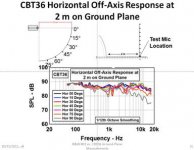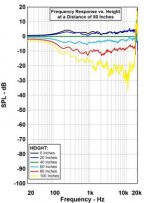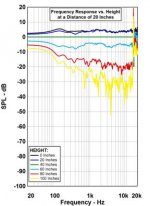Huh ? That statement is a complete non sequitur.The advantage is that compared to domes or cones they can produce adequate SPLs with little audible distortion. Thus you don't have to pad the down the LF driver.
What does a tweeter being able to (or not) produce high SPL at low distortion have to do with padding the low frequency driver down ?
I'm sure you really mean level matching due to different driver sensitivities, but in that case, what sensible design (passive at least) would ever pad a woofer down to match a low sensitivity tweeter ?
Since the sensitivity of the bass alignment is the limiting factor for overall sensitivity in a given size speaker, it would be incredibly wasteful to then pad that down for the sake of a low sensitivity tweeter when a higher sensitivity tweeter could usually be had in a package that wasn't significantly bigger...
Last edited:
Also it would depend on what one defines as "loud". A dome tweeter can easily reproduce 105-110 dB peaks, which would be sufficiently loud for many. A horn loaded dome tweeter could also be crossed over reasonably low.
Graaf,
So taking your solution to heart, at what point of using the so called flooder at the corner of the floor and wall now cause you to have just changed the surface that now becomes the new problem? Why with this design would not the ceiling of the room not become the analogous of a side wall as you are just moving about the x,y,z axis and saying if I move over here that you have solved the problem? I just see you shifting the problem, but it will still exist, just with a new direction. And we all should know by now that placing a sound source in a corner has just brought about a new set of challenges. Go ahead and put any shaped reproducer in a corner and tell me that you haven't changed everything and now excite the entire room with standing waves in a square or rectangular room. It is still the same as what I said about there being no Holy Grail of a perfect radiation source, you are just chasing you tail, you have just moved your tail to a new position.
So taking your solution to heart, at what point of using the so called flooder at the corner of the floor and wall now cause you to have just changed the surface that now becomes the new problem? Why with this design would not the ceiling of the room not become the analogous of a side wall as you are just moving about the x,y,z axis and saying if I move over here that you have solved the problem? I just see you shifting the problem, but it will still exist, just with a new direction. And we all should know by now that placing a sound source in a corner has just brought about a new set of challenges. Go ahead and put any shaped reproducer in a corner and tell me that you haven't changed everything and now excite the entire room with standing waves in a square or rectangular room. It is still the same as what I said about there being no Holy Grail of a perfect radiation source, you are just chasing you tail, you have just moved your tail to a new position.
Yes, it was. You cannot read that from the pdf file however. Se comments from Don Keele below. Maybe that clear things up a bit. 🙂"Uneven floor"? The floor shown in the linked PDF is not uneven at all!
The slide shows responses measured with the test mic on the floor. The 90° curve rolls off above 5 kHz because of roughness of the concrete floor in our shop. Measured over a shiny tile floor it’s essentially flat!
We are soon going to be measuring an additional set of CBT36 measurements of the response vs. height (0 to 2.5 m, step 0.5 m) at several off-axis horizontal angles (0 to 90°, step 15°). This will included with the B&W vs CBT36 measurements. We will measure this set over a good floor however!
In lieu of these measurements, the attached CBT36 simulations show essentially the same thing but simulated at several distances from the base of the array at 0.5, 1, 2, 3, 10, and 250 m. The simulations of course do not include box diffraction effects. Note that the aspect ratio of all graphs is 25 dB/decade.
Here’s the graph at 2 m from the base of the array and 75° off-axis horizontal:
The red curve is at a height of 2 m which is 0.5 m above the top of the array (array is 1.5 m tall) and is fully 10 dB below the 1 m listening height level! All curves are normalized to the response at 1 m high (green response curve) at that specific angle. Note that the level increases towards the floor (black, blue curves) but dramatically decreases as you go up (blue, red, and yellow curves).
Here’s the corresponding 75° curves, but much closer to the array at 0.5 m. Note that the 1.5 m level at the top of the array (blue) is 6 - 7 dB below the level at the listening height of 1 m. At a point igher at 0.5 m above the top of the array (red), the level is down some 15 to 20 dB but still fairly flat!
So what’s the conclusion? Yes the CBT36 does illuminate the walls, but with essentially a spectrum that is quite flat and that decreases considerably with height at distances particularly close to the array.
The behavior of the CBT36 over the ground is completely unique and is dramatically different and extraordinarily better than any speaker that has come before!! Just repeat the same set of over-the-floor measurements on any other manufacturer’s speaker and you will find out!
Attachments
Yes, it was. You cannot read that from the pdf file however. Se comments from Don Keele below. Maybe that clear things up a bit. 🙂
pardon me but what a floor type has to do with horizontal dispersion? it's horizontal dispersion of CBT that is so to speak deeply flawed
Why with this design would not the ceiling of the room not become the analogous of a side wall as you are just moving about the x,y,z axis
it wouldn't ...because the listener has not moved along x,y,z axis - the ceiling is still up there 🙂 and because perception of a ceiling reflection - a vertical reflection from an elevated angle - is completely different from perception of a lateral reflection, for many reasons
generally speaking the ceiling reflection is most probably quite neutral, because "ceilings" are so to speak ...very ...rare in nature 😉
it is a case very different from ground/floor reflection
this has been all discussed thoroughly in the flooder thread
I just see you shifting the problem, but it will still exist, just with a new direction.
I hope You can now see more clearly that this is not the case 🙂
And we all should know by now that placing a sound source in a corner has just brought about a new set of challenges. Go ahead and put any shaped reproducer in a corner and tell me that you haven't changed everything and now excite the entire room with standing waves in a square or rectangular room.
well - let's be precise - it is not a corner placement 🙂
and I think that standing waves and so on is a wholly separate issue, I believe that separate subs - mutliple or not - are the answer
and as the frequency band dominant in stereo perception in a reflective room starts around 500 Hz then side-wall-floor positioned stereo speakers needn't even to be fullrange
There was a danish research several years ago that came to the conclusion that the ceilling reflection was the worst one.
There was a danish research several years ago that came to the conclusion that the ceilling reflection was the worst one.
in case of a typical forward radiating box speaker, 2-way or more? I would say that it is a very different situation
anyway - it's very interesting - can You give any details about this research?
Sorry, I don't know much about it except I have seen Peter Lyngdorf refer to it. Don't know if he was the conducting the study or not. Peter Lyngdorf is the one behind Steinway speakers (picture below) and Lyngdorf speakers and elelectronics. Treating the ceiling is in my experience very important with waveguides too. Not so with CBTs......in case of a typical forward radiating box speaker, 2-way or more? I would say that it is a very different situation
anyway - it's very interesting - can You give any details about this research?
There's not much discussing when you guys cannot see that measurements in a normal room with uneven floor effects it.
For that reason we are still waiting for your comparison measurements you said you did 😉
There was a danish research several years ago that came to the conclusion that the ceilling reflection was the worst one.
Sorry, I don't know much about it except I have seen Peter Lyngdorf refer to it. Don't know if he was the conducting the study or not. Peter Lyngdorf is the one behind Steinway speakers (picture below) and Lyngdorf speakers and elelectronics.
Sounds like a perfect marketing statement for a company selling speakers with narrow vertical directivity 🙄
thanks anyway, I know Danish Archimedes research project under supervision of Professor Bech - they have indeed concluded that vertical reflections are undesirable although they didn't test specifically ceiling reflection, not to mention a floor coupled loudspeaker arrangement, and test's results were not - so to speak - perfectly clear 🙂
this is how David Moulton - Prof. Bech's collaborator - sums them up:
ps.
the evidence suggested - quite conservatively 😉 - that timbre may be audibly affected by floor and ceiling reflections
this is how David Moulton - Prof. Bech's collaborator - sums them up:
Right now there seems to be a fairly clear sense that vertical reflections (from the floor to the ceiling) tend to upset our perception. I'm not sure if that's true, but there is some evidence based on the Archimedes Project that was done in the early '90s in Denmark.
ps.
the evidence suggested - quite conservatively 😉 - that timbre may be audibly affected by floor and ceiling reflections
Last edited:
although they didn't test specifically ceiling reflection
They did, actually. It was not found to be a problem with a simulated 2-way KEF speaker, but it was found to cause colouration with a simulated perfect cardioid source.
Omholt, do you mean the Archimedes project?
Cookies Required
http://orbit.dtu.dk/fedora/objects/orbit:24002/datastreams/file_5317430/content
http://orbit.dtu.dk/fedora/objects/orbit:20024/datastreams/file_4425895/content
Cookies Required
http://orbit.dtu.dk/fedora/objects/orbit:24002/datastreams/file_5317430/content
http://orbit.dtu.dk/fedora/objects/orbit:20024/datastreams/file_4425895/content
Last edited:
There was a danish research several years ago that came to the conclusion that the ceilling reflection was the worst one.
Which research is this? Source please 🙂
They did, actually. It was not found to be a problem with a simulated 2-way KEF speaker, but it was found to cause colouration with a simulated perfect cardioid source.
I must have overlooked it - thanks! 🙂 especially as it supports my case that a ceiling reflection as such is not necessarily bad 🙂
Yes, it was. You cannot read that from the pdf file however. Se comments from Don Keele below. Maybe that clear things up a bit. 🙂
Thanks but the question remains if the directivity of the CBT is desirable or not.
By the way, about front wall reflections, from Toole page 116:
Not surprising since the front wall and floor reflection are quite similar except for minor differences in delay and vertical incidence.
Of course this also highlights that preference for side wall reflections is highly variable.
"When stereo listening tests were done in the two
versions of the room, it was found that the condition with absorbing side walls
was preferred for monitoring of the recording process and examining audio
products, whereas reflective side walls (which reduced IACC) were preferred
when listeners were simply “enjoying the music.” As might be expected, reflective side walls resulted in a “broadening of the sound image.” Adding absorption to the front wall, behind the loudspeakers, reportedly improved image localization and reduced coloration.
Not surprising since the front wall and floor reflection are quite similar except for minor differences in delay and vertical incidence.
Of course this also highlights that preference for side wall reflections is highly variable.
Last edited:
Huh ? That statement is a complete non sequitur.
What does a tweeter being able to (or not) produce high SPL at low distortion have to do with padding the low frequency driver down ?
I'm sure you really mean level matching due to different driver sensitivities, but in that case, what sensible design (passive at least) would ever pad a woofer down to match a low sensitivity tweeter ?
Since the sensitivity of the bass alignment is the limiting factor for overall sensitivity in a given size speaker, it would be incredibly wasteful to then pad that down for the sake of a low sensitivity tweeter when a higher sensitivity tweeter could usually be had in a package that wasn't significantly bigger...
My prejudices are showing. Depends on where I want the crossover and what order, doesn't it? I like crossovers to be away from the sensitive part of my hearing and low crossovers can really heat up a conventional tweeter and I don't like the resulting compression. It means the woofer is too loud when the music gets big.
That's my story today and I'm sticking with it.🙂
By the way, about front wall reflections, from Toole page 116:
...
Not surprising since the front wall and floor reflection are quite similar except for minor differences in delay and vertical incidence.
yes indeed, I would only like to stress the fact that in those tests the front wall = wall behind the loudspeaker, which is a typical situation and in case of side-wall placement a la Beveridge front wall is just a wall in front of the listener
Of course this also highlights that preference for side wall reflections is highly variable.
Interesting that they concluded that damping on the front wall improved image localization, (something I knew already) given that apart from reflections which have bounced around the room before returning to reflect from the front wall, (by definition being late reflections) the only sound that might be getting attenuated is the lower midrange which is near or below the baffle step frequency of the speaker, which according to some shouldn't have any significant effect on image localization... 😉
So improvement in image localisation from front wall damping is either reduction in the lower midrange reflection which causes comb filtering, (showing low midrange does affect imaging) or its just an overall reduction in the level of reverberant field in the room, (and a consequent increase in direct to reflected ratio) or a combination of both.
Neither involve full spectrum early reflections.
Last edited:
- Status
- Not open for further replies.
- Home
- General Interest
- Room Acoustics & Mods
- Controlled vs wide dispersion in a normal living room environment..


